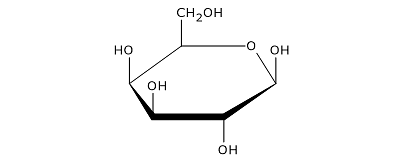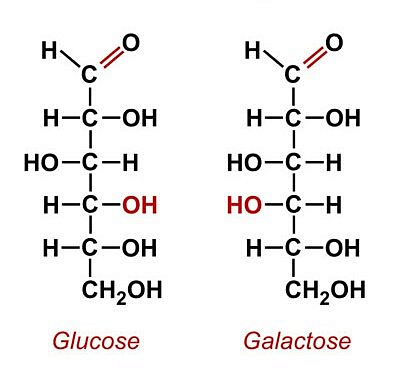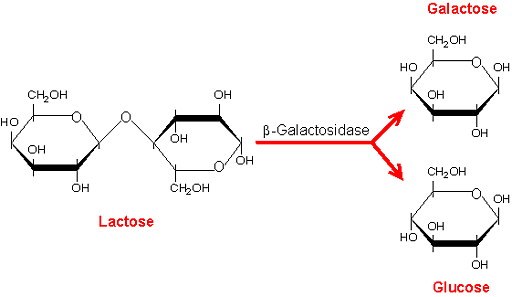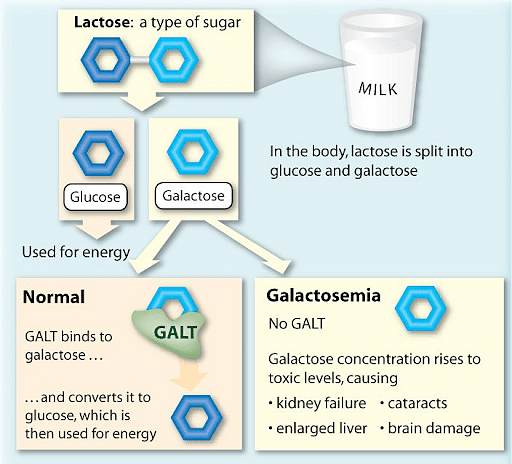Jasmine Grover Study Abroad Expert
Study Abroad Expert
Galactose is a monosaccharide sugar; the molecular formula of galactose sugar is C6H12O6. When a galactose molecule attaches to a glucose molecule, lactose is formed. It has a molecular mass of 180 g/mol. The density of this monosaccharide sugar is 1.2 g.cm3. Its main source in the diet is lactose which is found in milk and dairy products. Galactose is also present without lactose in a few vegetables and fruits. Galactosemia is a non-curable recessive genetic disorder that can be easily diagnosed at the time of birth and is fatal if not taken seriously. In this article, we’ll study what galactose is, its properties, sources, structure, and effects.
| Table of Content |
What is Galactose?
Galactose is a monosaccharide sugar. The molecular formula of galactose and glucose are the same; they both have the same number of Carbon (6), Hydrogen (12), and Oxygen (6) atoms. Galactose is a white solid that is odorless. It is a simple sugar that belongs to simple carbohydrates occurring in D-form in the lactose. Galactose shows resemblance with Glucose in every aspect except one. The only difference in galactose and glucose is the place of one hydroxyl group. However, this small structural difference gives different chemical and biochemical properties to the galactose when compared to glucose. Galactose exists in both cyclic and open-chain forms. It is generally found in avocados, sugar beets, dairy products, etc.

Galactose
Read Also: Carbohydrate Metabolism
Properties of Galactose
| IUPAC name | (3R,4S,5R,6R)-6-(hydroxymethyl)oxane-2,3,4,5-tetrol |
|---|---|
| Molecular formula | C6H12O6 |
| Molecular mass | 180 g/mol |
| Density | 1.5 g.cm3 |
| Melting point | -168-170° C |
- When galactose is present in a combined form with glucose, lactose is formed.
- When galactose is combined with lipids, glycolipids are formed.
- When galactose is combined with proteins, glycoproteins are formed.
Galactose Formula
Galactose is a monosaccharide sugar; the molecular formula of galactose is C6H12O6 and it has a molecular mass of 180 g/mol.
- Lactose is a disaccharide formed of two sugars, galactose, and glucose.
- Galactose exists in both cyclic and open-chain cyclic forms where the open-chain has a carbonyl group attached to the end of the chain.
- The major source of galactose in our diet is Lactose which is found in yogurt and milk. When these sources are digested, they form glucose and galactose.
- Foods that have a high amount of galactose include sweetened yogurt, milk-based puddings, celery, cherries, honey, hamburgers with condiments, kiwifruit, low-fat mozzarella, plums, and avocados.
Uses of Galactose
- Galactose is mainly found in lactose, in all dairy products. Lactose is only found in dairy products, but in some dairy products, the concentration of lactose is very less because the lactose has glucose which is used by microbes for their metabolic activities and energy production in the processing of food.
- Galactose is very important for energy delivery and metabolism in the human body.
- It is used in the study of the diagnosis and treatment of Hepatitis C, Wilsons Disease, Hepatic Cancer, Focal Segmental Glomerulosclerosis, Diabetic Macular Oedema, etc.
- Galactose is used for the generation of glucose fuel in the human body.
- Galactose is used as an important ingredient in some non-prescription products and some common vaccines.
- Lactose when hydrolyzed is used for the production of lactose hydrolysate syrup. This syrup is used as an artificial sweetener in many food processing industries like biscuits, toffees, chocolates, confectionery items, and some dairy products.
- Dairy products are the major source of lactose and galactose but are not the only source. The presence of lactose is also found in some non-dairy products, however, in very few amounts. Seeds and pulses have lactose in trace amounts.
- There are also some fruits and vegetables that contain galactose in its free form.
Structure of galactose
Galactose is a monosaccharide sugar, it is the C4 epimer of Glucose, which means the position of the (OH) group on C4 is different. It's axial in the case of galactose and equatorial in the case of glucose. The molecular formula of Gal (abbreviation for Galactose) is C6H12O6. The molar mass of Gal is 180 g/mol.

Conversion of Lactose to Galactose and Glucose
When galactose combines with glucose by performing a condensation reaction, then we get lactose as the product of the reaction which is a disaccharide sugar formed by the combination of monosaccharide sugars. Lactose is present in milk and dairy products. Lactase and galactosidase are the enzymes present in our body that separates galactose and glucose in their monosaccharide forms.
Through the process of the Leloir pathway, the Galactose metabolism or the conversion of galactose into glucose is carried out with the help of three major enzymes which are:
- Galactokinase (GALK),
- Galactose-1-phosphate uridyltransferase (GALT), and
- UDP-galactose-4'-epimerase (GALE)
Hexoneogenesis helps in the conversion of glucose into galactose in human lactation. Lactose in breast milk is majorly formed from galactose which is taken from the blood.

Effects of Galactose
Galactose is less soluble than Glucose that is why in the human body galactose is first converted to glucose and then further digestion and ATP formation take place. But if in any case, this conversion doesn’t take place then the human and other animals’ bodies can undergo severe suffering like in the case of mice, rats, and drosophila, senescence is accelerated if galactose's presence is not controlled. In the human body too, the result can be life-threatening and can cause several problems including underdeveloped body and body parts from the newborn stage.
Also Read:
Metabolism of Galactose
- In the liver, galactose is firstly converted to glucose l-phosphate and then is transformed to glucose 6-phosphate.
- The first and the very important step is the Galactokinase phosphorylation. The enzyme Galactokinase exists in two isoforms that are genetically distinct and that have different tissue distributions.
- People having defective galactokinase can develop cataracts in childhood or early adulthood due to the accumulation of galactitol in the lenses.
- The next step is the conversion of UDP by UDP-glucose-hexose-i-phosphate uridylyltransferase.
- A magnesium dependant enzyme known as phosphoglucomutase then converts glucose 1-phosphate to glucose 6-phosphate, which is an easily metabolized intermediate.
- NADPH-dependent aldehyde reductase, in the presence of Gal abundance, will reduce Galactose to galactitol as an alternative.
The β-galactosidase present in the yogurt converts the milk sugar(lactose) into its two constituents that are galactose and glucose and that is why curd is easy to digest by human beings because one step is skipped here. Free galactose is then absorbed by the mucosa of the small intestine. After its absorption galactose is further transported to the liver where its complete absorption takes place.

Metabolism of Galactose
Check out: Difference between DNA and RNA
Galactosemia
- Galactosemia is a hereditary disorder wherein the ability of the body of a person to convert Galactose into glucose is lost. Therefore, the person experiences a problem in carbohydrate metabolism and is unable to digest milk and dairy products.
- This disorder turns the body deficient in Galactose-1-phosphate uridylyltransferase (GALT) enzyme which is very important for the conversion of galactose into glucose.
- As the disorder is genetically transferred, the treatment should start as soon as possible after the birth otherwise the disorder can be life-threatening and can also result in intellectual disability.
Cause of disorder
- Galactosemia is caused by the changes (mutation) in the GALT gene (galactose-1-phosphate uridyl transferase) which results in the deficiency of the GALT enzyme which is important in the conversion of galactose into glucose and because of its deficiency the abnormal amount of galactose-based chemicals is accumulated in different organs of the body which ultimately causes or results in symptoms that clarify the galactosemia.
- As Galactosemia is an autosomal recessive disorder it is caused only when the child gets a non-working gene from both his/her parents. If the person receives an infected gene from one parent and another non-working gene from the other parent then the child will only be a carrier of the disease, but symptoms of galactosemia will not be shown by their own body.
Therapies for galactosemia
- The disease is non-curable but some therapies can help with symptoms of galactosemia.
- Children suffering from galactosemia should have a strict diet with a lactose-restricted (dairy-free) food like lactose-free milk, soybean, etc
- Satisfactory physical and mental development can be seen in children affected with galactosemia by providing them nutrients that are galactose-free.
Things to remember
- Galactose is a monosaccharide sugar; the molecular formula of galactose sugar is C6H12O6.
- The molecular formula and molecular mass of galactose and glucose are the same.
- Its molecular mass is 180 g/mol.
- The only difference in galactose and glucose is the place of one hydroxyl group.
- Galactose is a sugar of reducing nature.
- Galactose and Glucose are optical isomers
- Most of the galactose is found in lactose, which is a disaccharide sugar comprised of glucose and galactose.
- Galactosemia is the inability of the body to breakdown galactose because of some point mutation in the autosomal part of DNA which is inherited from the parents,
- Galactosemia should be diagnosed in the earliest stage otherwise can be life-threatening and can also affect the body and mind of a child.
Sample Questions
Ques. What is the molecular formula and molar mass of galactose? (2 marks)
Ans. The molecular formula galactose is C6H12O6 and its molar mass is 180.
Ques. What is the difference between galactose and glucose? (2 marks)
Ans. The structural difference between glucose and galactose is in the position of the hydroxyl group on the C4 atom. But in chemical and biochemical properties both are different monosaccharide sugars that perform different reactions
Ques. What is the main source of galactose? (3 marks)
Ans. The main source of galactose is lactose; lactose is a disaccharide sugar that consists of both galactose and glucose. The main source of lactose (and galactose) is milk and dairy products, in some vegetables and fruits the galactose is also present in pure form but in trace amounts.
Ques. What is the process involved in the digestion of galactose in the human body? (5 marks)
Ans. At first, the lactose is converted into galactose and glucose by the action of an enzyme call lactase in our stomach then the phosphorylation of galactose to galactose 1-phosphate by galactokinase takes place after which the last step of glycolysis changes the galactose into glucose, this whole process of conversion occurs in the mucosal membrane of the small intestine. After the conversion of galactose into glucose, the glucose is absorbed by the blood by different methods and then completely digested.
Ques. What is the IUPAC name of galactose? (1 mark)
Ans. The IUPAC name of galactose is (3R,4S,5R,6R)-6-(hydroxymethyl) oxane-2,3,4,5-tetrol
Ques. Name a disease caused by galactose and explain? (5 marks)
Ans. Galactosemia
- Galactosemia is a hereditary disorder that affects the ability of the person’s body to convert Galactose to glucose.
- The person experiences issues in carbohydrate metabolism and is unable to digest milk and dairy products.
- This disorder is caused by the deficiency of galactose-1-phosphate uridylyl transferase (GALT).
- It is an autosomal recessive disorder.
- Galactosemia is caused by the changes (mutation) in the GALT gene (galactose-1-phosphate uridyl transferase) which results in the deficiency of the GALT enzyme which is important in the conversion of galactose into glucose and because of its deficiency the abnormal amount of galactose-based chemicals is accumulated in different organs of the body which ultimately causes or results in symptoms that clarify the galactosemia.
Ques. Discuss metabolic reaction of galactose inside and outside the human body? (3 marks)
Ans. Lactose is hydrolyzed in the intestine by the intestinal lactase that leads to the release of Galactose with a glucose molecule, the reaction that takes place is called glycosidic reaction. The β-galactosidase present in the yogurt converts the milk sugar(lactose) into its two constituents that are in galactose and glucose and that is why curd is easy to digest by human beings because one step is skipped here. Free galactose is then absorbed by the mucosa of the small intestine. After its absorption galactose is further transported to the liver where its complete absorption takes place.





Comments